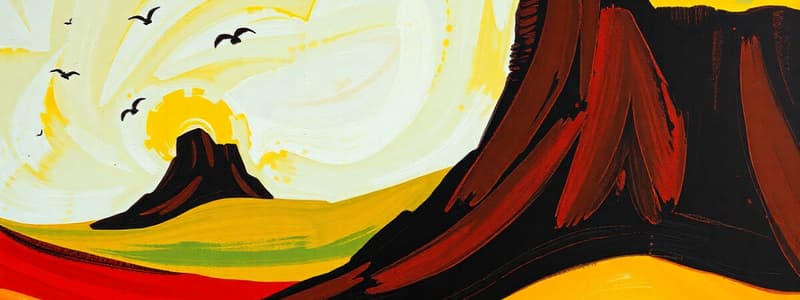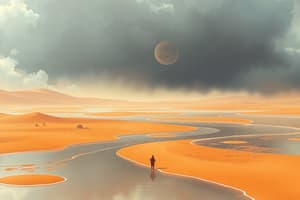Podcast
Questions and Answers
Which of the following characteristics best describes a desert environment?
Which of the following characteristics best describes a desert environment?
- Consistent cloud cover and high humidity
- Moderate temperatures and abundant wildlife
- Low rainfall, sparse vegetation, and extreme temperatures (correct)
- High rainfall and dense vegetation
The Sahara Desert consists only of sand dunes.
The Sahara Desert consists only of sand dunes.
False (B)
Name three of the eleven countries that the Sahara Desert touches.
Name three of the eleven countries that the Sahara Desert touches.
Algeria, Chad, and Egypt
The highest temperature ever recorded in the Sahara Desert was 57.7°C in the city of _______.
The highest temperature ever recorded in the Sahara Desert was 57.7°C in the city of _______.
What is a key factor that contributes to the Sahara Desert's scorching hot climate?
What is a key factor that contributes to the Sahara Desert's scorching hot climate?
Match the following desert features with their descriptions:
Match the following desert features with their descriptions:
Temperatures in the Sahara Desert remain consistently high both during the day and night.
Temperatures in the Sahara Desert remain consistently high both during the day and night.
Which of the following animals are commonly found in the Sahara Desert?
Which of the following animals are commonly found in the Sahara Desert?
Which of the following environmental changes primarily led to the Sahara desert's current state?
Which of the following environmental changes primarily led to the Sahara desert's current state?
Oases are formed when wind deposits sand, creating fertile areas with water access.
Oases are formed when wind deposits sand, creating fertile areas with water access.
Name two nomadic tribes that inhabit the Sahara desert.
Name two nomadic tribes that inhabit the Sahara desert.
The discovery of ______ in Algeria, Libya, and Egypt is transforming the Sahara Desert.
The discovery of ______ in Algeria, Libya, and Egypt is transforming the Sahara Desert.
Match the following animals with their uses by the nomadic tribes of the Sahara:
Match the following animals with their uses by the nomadic tribes of the Sahara:
Which of the following crops is NOT typically grown in the oases and Nile Valley of Egypt?
Which of the following crops is NOT typically grown in the oases and Nile Valley of Egypt?
Ladakh is a hot desert located near the Zanskar mountains.
Ladakh is a hot desert located near the Zanskar mountains.
Name the most important river that flows through Ladakh.
Name the most important river that flows through Ladakh.
Ladakh is also known as ______, which means snow land.
Ladakh is also known as ______, which means snow land.
What is the primary reason for the sparse vegetation in Ladakh?
What is the primary reason for the sparse vegetation in Ladakh?
The population of Ladakh is primarily Christian.
The population of Ladakh is primarily Christian.
Name two common bird species found in Ladakh.
Name two common bird species found in Ladakh.
Which of the following factors contributes most to the intense sunlight felt in Ladakh?
Which of the following factors contributes most to the intense sunlight felt in Ladakh?
The Chiru, or Tibetan antelope, is hunted for its wool known as ______.
The Chiru, or Tibetan antelope, is hunted for its wool known as ______.
Match the following monasteries with their location in Ladakh:
Match the following monasteries with their location in Ladakh:
Flashcards
Deserts
Deserts
Areas with low rainfall, sparse vegetation, and extreme temperatures.
Hot Desert
Hot Desert
A desert characterized by extremely high temperatures.
Sahara Desert
Sahara Desert
The largest hot desert in the world, located in North Africa.
Desert (Glossary Definition)
Desert (Glossary Definition)
Signup and view all the flashcards
Highest Sahara Temp
Highest Sahara Temp
Signup and view all the flashcards
Sahara Climate
Sahara Climate
Signup and view all the flashcards
Sahara Vegetation
Sahara Vegetation
Signup and view all the flashcards
Sahara Animals
Sahara Animals
Signup and view all the flashcards
Sahara Cave Paintings Significance
Sahara Cave Paintings Significance
Signup and view all the flashcards
Oasis Formation
Oasis Formation
Signup and view all the flashcards
Oasis
Oasis
Signup and view all the flashcards
Tafilalet Oasis
Tafilalet Oasis
Signup and view all the flashcards
Bedouins and Tuaregs
Bedouins and Tuaregs
Signup and view all the flashcards
Livestock Uses in Sahara
Livestock Uses in Sahara
Signup and view all the flashcards
Egyptian Cotton
Egyptian Cotton
Signup and view all the flashcards
Oil in the Sahara
Oil in the Sahara
Signup and view all the flashcards
Ladakh
Ladakh
Signup and view all the flashcards
Karakoram and Zanskar Range
Karakoram and Zanskar Range
Signup and view all the flashcards
Indus River in Ladakh
Indus River in Ladakh
Signup and view all the flashcards
Ladakh Climate
Ladakh Climate
Signup and view all the flashcards
Ladakh Vegetation
Ladakh Vegetation
Signup and view all the flashcards
Ladakh People
Ladakh People
Signup and view all the flashcards
Hemis, Thiksey, Shey and Lamayuru
Hemis, Thiksey, Shey and Lamayuru
Signup and view all the flashcards
Study Notes
- Water is essential for life for plants, animals, and people
- It is difficult to live in areas without water for drinking, cattle grazing, and crop growth
Desert Areas
- Characterized by low rainfall, scarce vegetation, and extreme temperatures
- Can be hot or cold, depending on the temperature
- People inhabit these lands where water is available for agriculture
The Hot Desert - Sahara
- Located in North Africa, and is the world's largest desert,
- Has an area of approximately 8.54 million sq. km
- Touches eleven countries: Algeria, Chad, Egypt, Libya, Mali, Mauritania, Morocco, Niger, Sudan, Tunisia, and Western Sahara
- Consists of vast stretches of sand, gravel plains, and elevated plateaus with bare rocky surfaces
- Rocky surfaces can exceed 2500m in height
Climate
- Characterized as scorching hot and parch dry with a short rainy season
- Sky is cloudless and clear, with moisture evaporating quickly
- Daytime temperatures can reach as high as 50°C
- Nights can be freezing cold, with temperatures near zero degrees
Flora
- Includes cactus, date palms, and acacia
- Oases are green islands with date palms
Fauna
- Includes camels, hyenas, jackals, foxes, scorpions, snakes, and lizards
People
- Inhabited by groups such as the Bedouins and Tuaregs
- These are nomadic tribes who rear livestock like goats, sheep, camels, and horses
- Livestock provides milk and hides to make leather for belts, slippers, and water bottles
- Hair is used for mats, carpets, clothes, and blankets
- People wear heavy robes for protection against dust storms and hot winds
- Oases and the Nile Valley in Egypt support settled populations
- Crops grown include rice, wheat, barley, beans, and Egyptian cotton
- The discovery of oil in Algeria, Libya, and Egypt is transforming the Sahara
- Other minerals found include iron, phosphorus, manganese, and uranium
- The cultural landscape is changing, with modern buildings and highways replacing traditional structures
- Trucks are replacing camels in the salt trade
- Nomadic herdsmen are finding jobs in oil and gas operations
The Cold Desert - Ladakh
- Located in the Great Himalayas, on the eastern side of Jammu and Kashmir
- Enclosed by the Karakoram Range in the north and the Zanskar mountains in the south
- Several rivers flow through it, with the Indus being the most important, forming deep valleys and gorges
- Home to several glaciers, such as the Gangri glacier
- Altitude varies from about 3000m in Kargil to over 8,000m in the Karakoram
- Climate is extremely cold and dry due to the high altitude
- Air is thin, causing intense sunlight
- Summer day temperatures are just above zero degrees, while night temperatures are well below -30°C
- Winter temperatures may remain below -40°C for most of the time
- Lies in the rain shadow of the Himalayas, resulting in low rainfall, as low as 10 cm annually
- Experiences freezing winds and burning hot sunlight
Flora
- Sparse vegetation due to high aridity
- Scanty patches of grasses and shrubs for animals to graze
- Groves of willows and poplars in the valleys
- Fruit trees such as apples, apricots, and walnuts bloom during the summers
Fauna
- Includes wild goats, wild sheep, yak, and special kinds of dogs
- Animals are reared for milk, meat, and hides
- Yak's milk is used for cheese and butter
- The hair of sheep and goats is used to make woolens
People
- Similar to the inhabitants of Tibet and Central Asia
- Either Muslims or Buddhists
- Features Buddhist monasteries called 'gompas'
- Some famous monasteries are Hemis, Thiksey, Shey, and Lamayuru
- Summers are spent cultivating barley, potatoes, peas, beans, and turnip
- Harsh winter climate leads to people engaging in festivities and ceremonies
- Women are hardworking, managing household, fields, small businesses, and shops
- Leh, the capital, is well connected by road and air
- National Highway 1 connects Leh to Kashmir Valley through the Zoji La Pass
- Tourism is a major activity
- People have learned to live in balance with nature due to scarcity of resources like water and fuel
Studying That Suits You
Use AI to generate personalized quizzes and flashcards to suit your learning preferences.




